
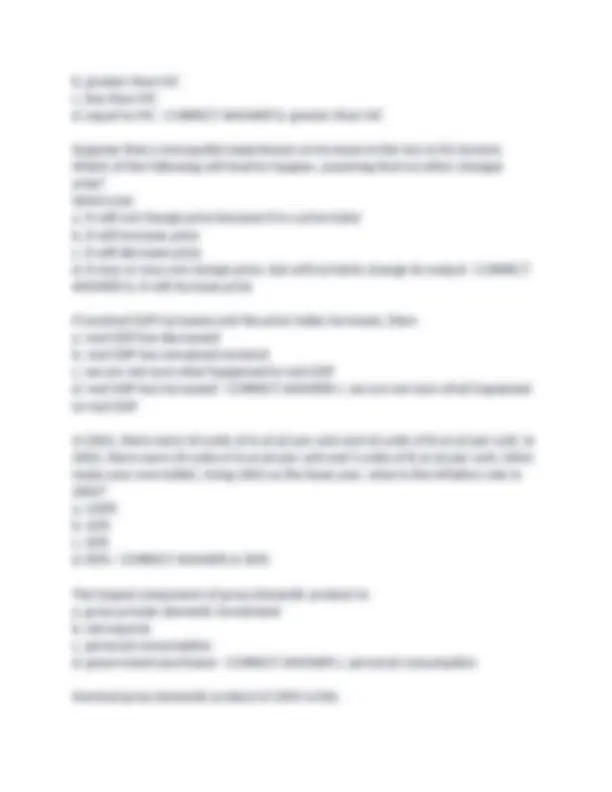
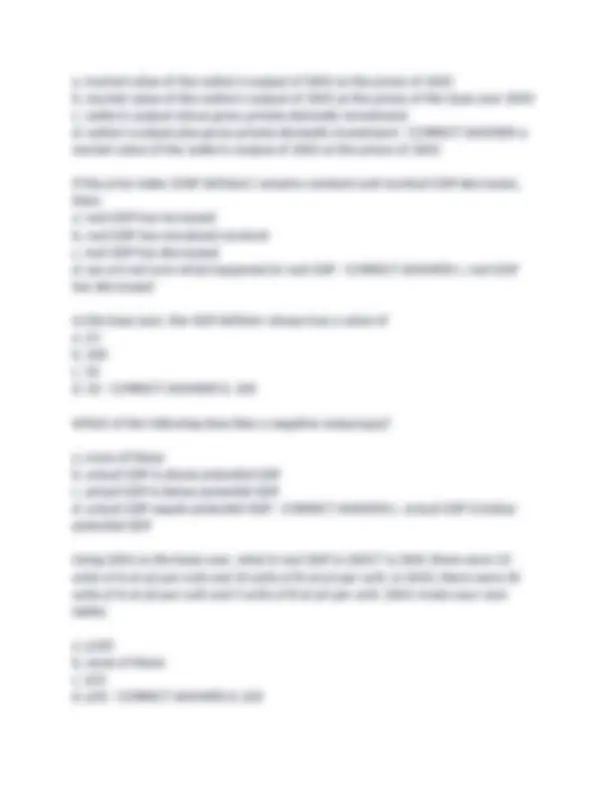
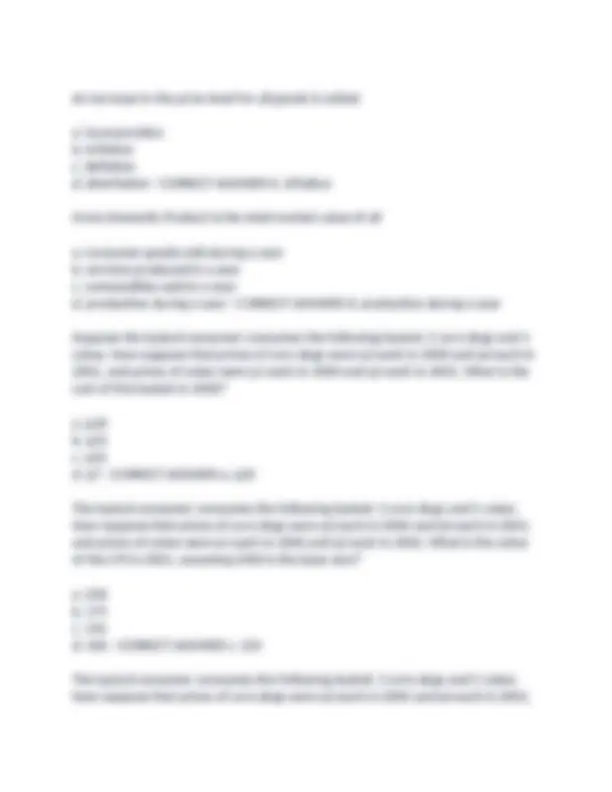
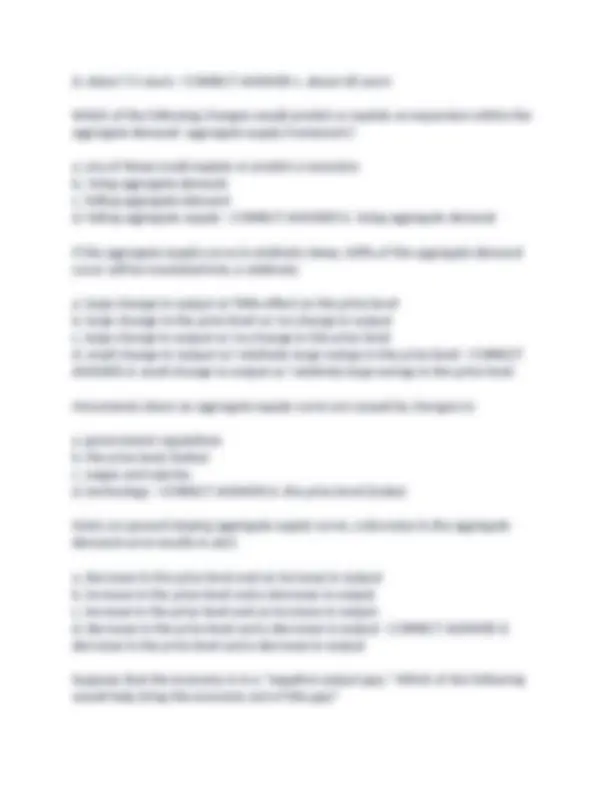
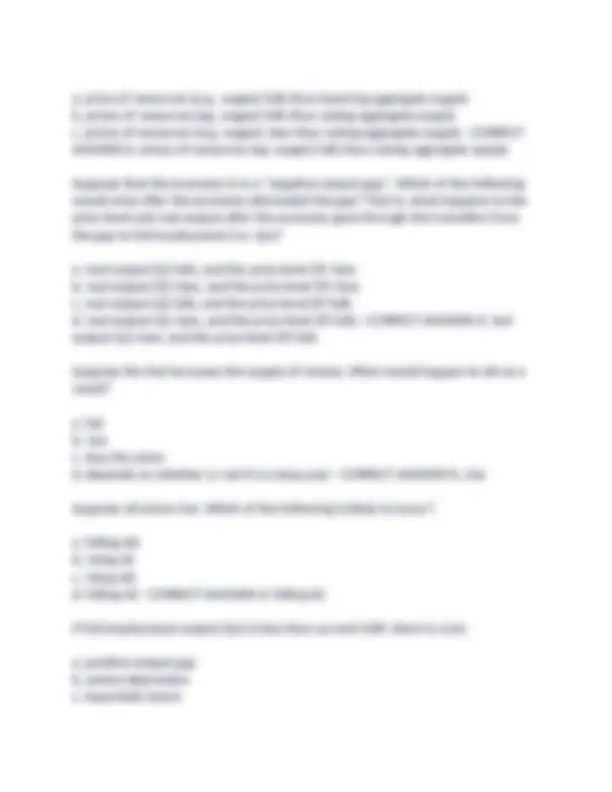
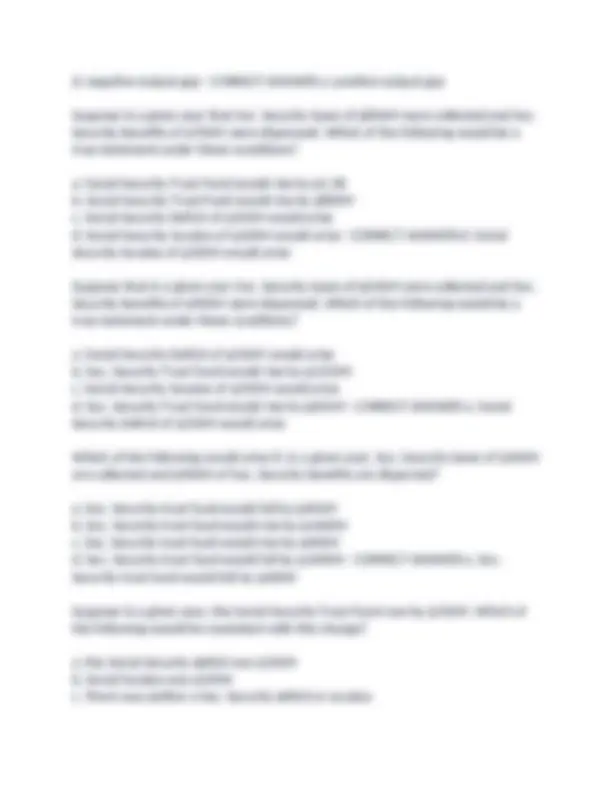
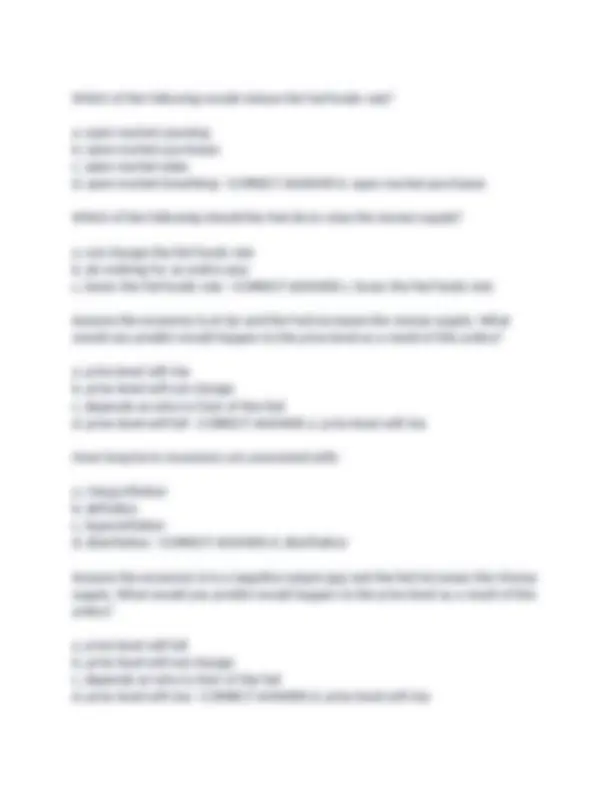
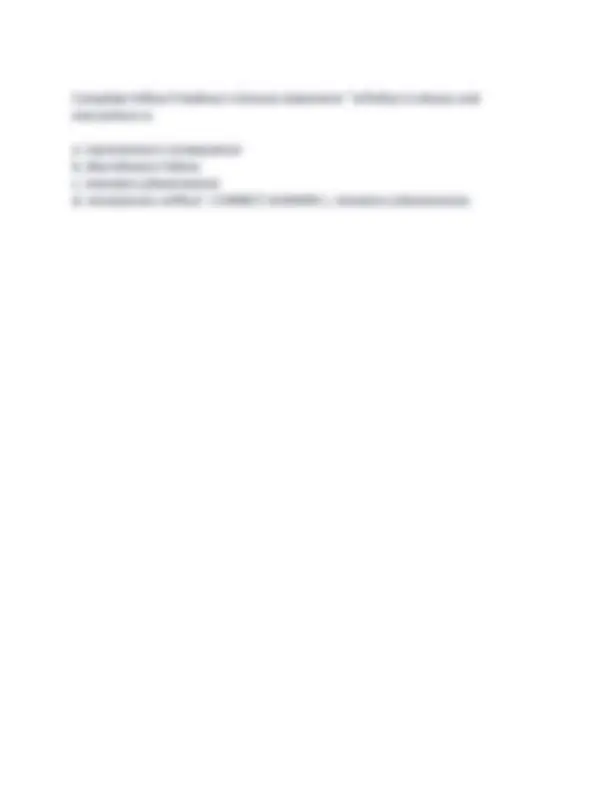


Study with the several resources on Docsity

Earn points by helping other students or get them with a premium plan


Prepare for your exams
Study with the several resources on Docsity

Earn points to download
Earn points by helping other students or get them with a premium plan
Community
Ask the community for help and clear up your study doubts
Discover the best universities in your country according to Docsity users
Free resources
Download our free guides on studying techniques, anxiety management strategies, and thesis advice from Docsity tutors
This study guide for econ 201 covers a range of topics in microeconomics, including monopoly, market demand, marginal revenue, and inflation. It presents 61 multiple-choice questions with verified answers, providing a comprehensive review of key concepts and principles. The guide is particularly useful for students preparing for their final exam in econ 201.
Typology: Exams
1 / 14

This page cannot be seen from the preview
Don't miss anything!









The marginal revenue curve of a monopolist lies below the demand curve because: a. the marginal revenue curve coincides w/ the average revenue curve b. the monopolist is a price taker c. the monopolist must lower price on all units sold in order to sell additional units d. the demand curve is unit elastic - CORRECT ANSWER c. the monopolist must lower price on all units sold in order to sell additional units A monopolist: a. can choose any price along the market curve b. takes the price of its product as given and produces as much output as possible c. chooses the price of its product so as to maximize the number of sales d. can choose any price it wants, regardless of demand. - CORRECT ANSWER a. can choose any price along the market curve The market demand curve and the demand curve faced by a monopoly are: a. different, but we can't tell which is more elastic w/o more information b. different in that the market demand curve is less elastic c. different in that the market demand curve is more elastic d. identical - CORRECT ANSWER d. identical If the monopolist is operating in the elastic portion of its demand curve, then a. an increase in price will decrease total revenues b. an increase in price will leave total revenue unchanged c. marginal revenue is negative d. an increase in price will increase total revenues - CORRECT ANSWER a. an increase in price will decrease total revenues Assume that Bost, Incorporated sells game cartridges that can be used in a popular home video system. Bost currently sells 300 cartridges per week and earns $500 in profit. Bost's production manager calculates that the marginal cost
of the next unit is $5, while marginal revenue for one additional unit is $10. Based upon this info we would conclude that: a. Insufficient information b. Bost should reduce their output c. Bost's profit would rise to $505 by increasing output 1 unit d. Bost's profit would rise to $510 by increasing output 1 unit - CORRECT ANSWER c. Bost's profit would rise to $505 by increasing output 1 unit Generally, we expect monopolies to (blank) output when demand for their product rises. Select one: a. double b. not change c. decrease d. increase - CORRECT ANSWER d. increase Compared to a competitive industry, ceteris paribus, a monopoly Select one: a. restricts output and charges a higher price b. sells the same amount of units but at a higher price c. sells more units and charges a higher price d. does not try to maximize profits as do firms in competitive industries - CORRECT ANSWER a. restricts output and charges a higher price Consider a monopolist that is currently maximizing profit by producing 10 units. Which of the following statements is not true? Select one: a. price is greater than marginal cost b. price is less than marginal cost c. price is greater than marginal revenue d. profit will fall if it decreases its production e. profit will fall if it increases its production - CORRECT ANSWER b. price is less than marginal cost To maximize profits, a monopolist will charge a price that is: Select one: a. insufficient information
a. market value of the nation's output of 2005 at the prices of 2005 b. market value of the nation's output of 2005 at the prices of the base year 2000 c. nation's output minus gross private domestic investment d. nation's output plus gross private domestic investment - CORRECT ANSWER a. market value of the nation's output of 2005 at the prices of 2005 If the price index (GDP Deflator) remains constant and nominal GDP decreases, then: a. real GDP has increased b. real GDP has remained constant c. real GDP has decreased d. we are not sure what happened to real GDP - CORRECT ANSWER c. real GDP has decreased In the base year, the GDP deflator always has a value of a. 25 b. 100 c. 50 d. 10 - CORRECT ANSWER b. 100 Which of the following describes a negative output gap? a. none of these b. actual GDP is above potential GDP c. actual GDP is below potential GDP d. actual GDP equals potential GDP - CORRECT ANSWER c. actual GDP is below potential GDP Using 2001 as the base year, what is real GDP in 2001? In 2001 there were 10 units of A at $2 per unit and 10 units of B at $3 per unit. In 2002, there were 20 units of A at $4 per unit and 5 units of B at $4 per unit. (Hint: make your own table). a. $ b. none of these c. $ d. $50 - CORRECT ANSWER d. $
An increase in the price level for all goods is called: a. incorporation b. inflation c. deflation d. disinflation - CORRECT ANSWER b. inflation Gross Domestic Product is the total market value of all a. consumer goods sold during a year b. services produced in a year c. commodities sold in a year d. production during a year - CORRECT ANSWER d. production during a year Suppose the typical consumer consumes the following basket: 5 corn dogs and 5 cokes. Now suppose that prices of corn dogs were $3 each in 2000 and $4 each in 2001, and prices of cokes were $1 each in 2000 and $2 each in 2001. What is the cost of this basket in 2000? a. $ b. $ c. $ d. $7 - CORRECT ANSWER a. $ The typical consumer consumes the following basket: 5 corn dogs and 5 cokes. Now suppose that prices of corn dogs were $3 each in 2000 and $4 each in 2001, and prices of cokes were $1 each in 2000 and $2 each in 2001. What is the value of the CPI in 2001, assuming 2000 is the base year? a. 200 b. 175 c. 150 d. 100 - CORRECT ANSWER c. 150 The typical consumer consumes the following basket: 5 corn dogs and 5 cokes. Now suppose that prices of corn dogs were $3 each in 2000 and $4 each in 2001,
c. lenders prefer inflation to be higher than expected during the life of a loan - CORRECT ANSWER c. lenders prefer inflation to be higher than expected during the life of a loan Which of the following best describes a period of disinflation? a. price stability is occurring b. inflation is occurring c. hyperinflation is occurring d. deflation is occuring - CORRECT ANSWER b. inflation is occurring Unexpected inflation tends to benefit: a. lenders b. debtors c. retired workers d. suppliers - CORRECT ANSWER b. debtors A current value of 125 for the CPI means that, on average: a. a given money income has 25% more purchasing power than during the base year b. prices are now 25% less than in the base year c. a dollar today buys what $1.25 bought in the base year d. it now costs roughly $1.25 to buy goods that cost $1.00 in the base year - CORRECT ANSWER d. it now costs roughly $1.25 to buy goods that cost $1.00 in the base year Need to study the money lecture and tutorial because you were a jackass and did not take the quiz - CORRECT ANSWER dfasd Suppose real GDP is growing at 4%. If the rate persisted, how many years would it take for real GDP to double? a. about 10 years b. about 5.6 years c. about 18 years
d. about 7.5 years - CORRECT ANSWER c. about 18 years Which of the following changes would predict or explain an expansion within the aggregate demand- aggregate supply framework? a. any of these could explain or predict a recession b. rising aggregate demand c. falling aggregate demand d. falling aggregate supply - CORRECT ANSWER b. rising aggregate demand If the aggregate supply curve is relatively steep, shifts of the aggregate demand curve will be translated into a relatively: a. large change in output w/ little effect on the price level b. large change in the price level w/ no change in output c. large change in output w/ no change in the price level d. small change in output w/ relatively large swings in the price level - CORRECT ANSWER d. small change in output w/ relatively large swings in the price level Movements down an aggregate supply curve are caused by changes in: a. government regulations b. the price level (index) c. wages and salaries d. technology - CORRECT ANSWER b. the price level (index) Given an upward sloping aggregate supply curve, a decrease in the aggregate demand curve results in a(n): a. decrease in the price level and an increase in output b. increase in the price level and a decrease in output c. increase in the price level and an increase in output d. decrease in the price level and a decrease in output - CORRECT ANSWER d. decrease in the price level and a decrease in output Suppose that the economy is in a "negative output gap." Which of the following would help bring the economy out of this gap?
d. negative output gap - CORRECT ANSWER a. positive output gap Suppose in a given year that Soc. Security taxes of $800M were collected and Soc. Security benefits of $700M were dispensed. Which of the following would be a true statement under these conditions? a. Social Security Trust Fund would rise by $1.5B b. Social Security Trust Fund would rise by $800M c. Social Security Deficit of $100M would arise d. Social Security Surplus of $100M would arise - CORRECT ANSWER d. Social Security Surplus of $100M would arise Suppose that in a given year Soc. Security taxes of $650M were collected and Soc. Security benefits of $900M were dispensed. Which of the following would be a true statement under these conditions? a. Social Security Deficit of $250M would arise b. Soc. Security Trust Fund would rise by $1550M c. Social Security Surplus of $250M would arise d. Soc. Security Trust Fund would rise by $650M - CORRECT ANSWER a. Social Security Deficit of $250M would arise Which of the following would arise if, in a given year, Soc. Security taxes of $500M are collected and $900M of Soc. Security benefits are dispersed? a. Soc. Security trust fund would fall by $400M b. Soc. Security trust fund would rise by $1400M c. Soc. Security trust fund would rise by $400M d. Soc. Security trust fund would fall by $1400M - CORRECT ANSWER a. Soc. Security trust fund would fall by $400M Suppose in a given year, the Social Security Trust Fund rose by $350M. Which of the following would be consistent with this change? a. the Social Security deficit was $350M b. Social Surplus was $350M c. There was neither a Soc. Security deficit or surplus
d. Soc. Security deficit equaled Soc. Security surplus - CORRECT ANSWER b. Social Surplus was $350M Which of the following would extend the ability of Soc. Security to make payments? a. increase in retirees relative to workers b. an increase in social security benefits c. higher retirement age d. decrease in social security tax rates - CORRECT ANSWER c. higher retirement age Which of the following best explains why Social Security is a "transfer" program? a. benefits paid to today's retirees are funded by today's workers b. benefits paid to today's retirees are funded by those same retirees c. the economic incidence of the social security tax falls entirely on the worker d. the employer pays one-half of the social security tax bill for each worker - CORRECT ANSWER a. benefits paid to today's retirees are funded by today's workers All of the following are considered social insurance programs except: a. Medicaid b. Unemployment Insurance c. Social Security d. federal flood insurance - CORRECT ANSWER d. federal flood insurance All of the following are considered rationales for social insurance programs except: a. paternalism b. lack of private markets c. promote efficiency d. promote equity - CORRECT ANSWER c. promote efficiency What is the statutory incidence of the social security tax?
Which of the following would reduce the fed funds rate? a. open market yawning b. open market purchases c. open market sales d. open market breathing - CORRECT ANSWER b. open market purchases Which of the following should the Fed do to raise the money supply? a. not change the fed funds rate b. do nothing for an entire year c. lower the fed funds rate - CORRECT ANSWER c. lower the fed funds rate Assume the economy is at Qn and the Fed increases the money supply. What would you predict would happen to the price level as a result of this action? a. price level will rise b. price level will not change c. depends on who is Chair of the Fed d. price level will fall - CORRECT ANSWER a. price level will rise Most long-term recessions are associated with: a. rising inflation b. deflation c. hyperinflation d. disinflation - CORRECT ANSWER d. disinflation Assume the economy is in a negative output gap and the fed increases the Money supply. What would you predict would happen to the price level as a result of this action? a. price level will fall b. price level will not change c. depends on who is chair of the fed d. price level will rise - CORRECT ANSWER d. price level will rise
Complete Milton Friedman's famous statement: "Inflation is always and everywhere a: a. repressionary consequence b. discretionary failure c. monetary phenomenon d. recessionary artifact - CORRECT ANSWER c. monetary phenomenon